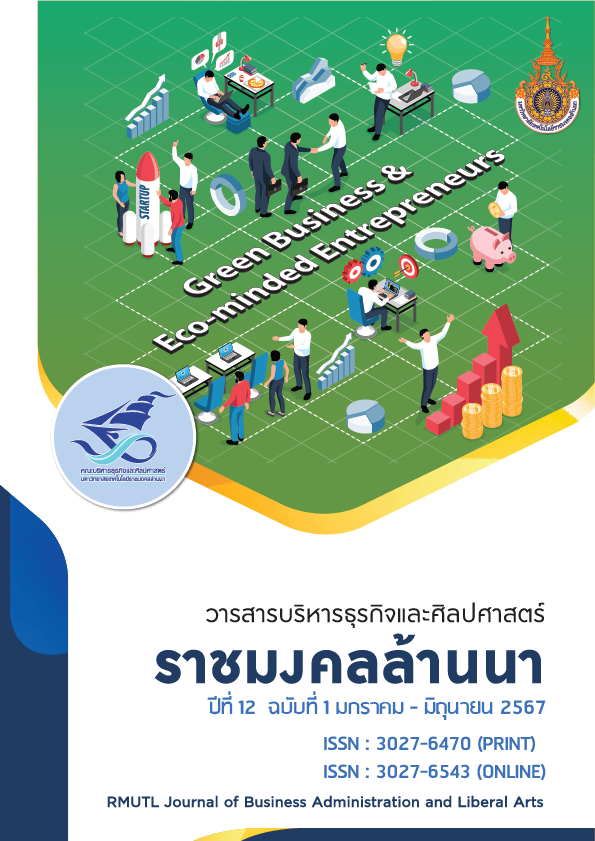Marketing Mix Factors Affecting Consumers’ Consuming Decision of Ketogenic Food in Muang District Kamphaeng Phet Province
Main Article Content
Abstract
The purposes of this research were 1) to study marketing mix factors and consumer decision to consume ketogenic food in Muang District Kamphaeng Phet Province and 2) to study the marketing mix factors affecting consumers decision in Muang District Kamphaeng Phet Province. The sample was 385 ketogenic food consumers who lived in the Muang District Kamphaeng Phet Province which were selected by purposive random sampling technique. The questionnaire was used as a tool for collecting data. Data were analyzed by using percentage, mean, standard deviation and multiple linear regression analysis. The results showed that most ketogenic food consumers were female, 31.18 years old in average, single and graduated with a bachelor's degree. Most of them were employees of private companies and earned 19,875.22 baht/month. The level of agreement towards overall marketing mix factors were moderate. When considering each dimension, it was found that product dimension was the highest. The consumer decision to consume ketogenic food was moderate. When considering in detail, it was found that they consume ketogenic food because it contained the most beneficial and nutritious nutrients. Finally, the results of the hypothesis testing revealed that marketing mix factors in terms of physical, price, promotion and product affecting the consumer decision to consume the ketogenic food were significant at the level of 0.05 with a predictive coefficient (R2) of 0.786
Article Details

This work is licensed under a Creative Commons Attribution-NonCommercial-NoDerivatives 4.0 International License.
บทความวิจัยนี้เป็นของลิขสิทธิ์
References
กมลวรรณ พงษ์กุล. (2565). ปัจจัยที่มีผลต่อแนวโน้มและข้อแนะนําการบริโภคอาหารคลีนเพื่อสุขภาพในทศวรรษ 2020. วารสารวิทยาศาสตร์และเทคโนโลยี มหาวิทยาลัยราชภัฏศรีสะเกษ, 2(2), AA1-AA9.
กรมควบคุมโรค กระทรวงสาธารณสุข. (2563). รายงานสถานการณ์โรค NCDs เบาหวาน ความดันโลหิตสูง และปัจจัยเสี่ยงที่เกี่ยวข้อง พ.ศ. 2562. กรุงเทพฯ: อักษรกราฟฟิคแอนด์ดีไซน์.
กุลณภัชร บุญทวี และสายพิณ ปั้นทอง. (2565). ปัจจัยที่มีอิทธิพลต่อการตัดสินใจซื้ออาหารคีโตเจนิคของผู้บริโภคในกรุงเทพมหานคร. วารสารสุทธิปริทัศน์, 36(4), 85-100.
จรรยา วังนิยม, นรภัทร สถานสถิตย์ และสุพาพร ลอยวัฒนากุล. (2563). ปัจจัยที่ส่งผลต่อพฤติกรรมการซื้ออาหารเพื่อสุขภาพ (Clean Food) ของประชากร ในเขตเทศบาลเมืองพัทยา จังหวัดชลบุรี. วารสารวิทยาการจัดการปริทัศน์, 22(2), 59-68.
ธัญลักษณ์ ถาวรจิต. (2564). การศึกษาพฤติกรรมผู้บริโภคอาหารเพื่อสุขภาพในเทศบาลนครหาดใหญ่ จังหวัดสงขลา. วารสารบริหารธุรกิจ มหาวิทยาลัยแม่โจ้, 3(1), 41-56.
นาตยา พีระวรรณกุล. (2565). พฤติกรรมการดูแลตนเองของผู้ป่วยโรคเบาหวานชนิดที่ 2 โรงพยาบาลพรานกระต่าย จังหวัดกำแพงเพชร. วารสารวิทยาศาสตร์และเทคโนโลยีนอร์ทเทิร์น, 3(3), 38-55.
นาเดียร์ อัสมะแอ และนรารัก บุญญานาม. (2563). ปัจจัยที่ส่งผลต่อการตัดสินใจซื้ออาหารคลีนผ่านสื่อออนไลน์ของนิสิตจุฬาลงกรณ์มหาวิทยาลัย จังหวัดกรุงเทพมหานคร. การประชุมวิชาการและนำเสนอผลงานวิชาการระดับชาติ UTCC Academic Day ครั้งที่ 4. 2395-2414.
ปาณิสรา เฉยบัว และนลินี เหมาะประสิทธิ์. (2563). ปัจจัยที่ส่งผลต่อการตัดสินใจซื้ออาหารคลีนในเขตอำเภอเมือง จังหวัดพิษณุโลก. วารสารเศรษฐศาสตร์และบริหารธุรกิจ มหาวิทยาลัยทักษิณ, 13(1), 131-142.
ปัทมา ตุงคะเสรีรักษ์ และไพรพันธ์ ธนเลิศโศภิต. (2563). ปัจจัยส่วนประสมทางการตลาดที่มีผลต่อการตัดสินใจซื้อสินค้าในตลาดชุมชนของผู้บริโภคในอำเภอเมืองลำพูน จังหวัดลำพูน. วารสารบริหารธุรกิจและศิลปศาสตร์ ราชมงคลล้านนา, 8(2), 13-32.
ศิรินุช เศรษฐพานิช และสุพิชา บูรณะวิทยาภรณ์. (2564). ปัจจัยที่ส่งผลต่อความตั้งใจซื้ออาหารทางเลือกประเภทโปรตีนจากพืช ในรูปแบบอาหารแห้ง-ขนมขบเคี้ยว สำหรับผู้สูงอายุในกรุงเทพมหานคร และแนวทางในการพัฒนาผลิตภัณฑ์. วารสารวิทยาลัยดุสิตธานี, 15(2), 412-428.
สุธาสินี ไถวศิลป์. (2563). คีโตจินิก ไดเอท (Ketogenic Diet) อาหารบำบัดโรคอ้วนและโรคเบาหวานประเภทที่ 2. กรุงเทพฯ: บริษัท วี อินดี้ ดีไซน์ จำกัด.
สำนักงานสถิติแห่งชาติ. (2561). การสำรวจพฤติกรรมการบริโภคอาหารของประชากร พ.ศ. 2560. กรุงเทพมหานคร: สำนักงานสถิติแห่งชาติ.
สำนักงานสาธารณสุขจังหวัดกำแพงเพชร. (2561). เอกสารประกอบ การตรวจราชการและนิเทศงาน กรณีปกติ กระทรวงสาธารณสุข ประจำปีงบประมาณ 2561 เขตสุขภาพที่ 3 รอบที่ 1. กำแพงเพชร: สำนักงานสาธารณสุขจังหวัดกำแพงเพชร.
Cochran, W. G. (1977). Sampling Techniques. (3rd ed.). New York: John Wiley and Sons.
Hair, J. F., Black, W. C., Babin, B. J. & Anderson, R. E. (2010). Multivariate data analysis. (7th ed.). Upper Saddle River, NJ: Pearson Prentice Hall.
Harrington, R. J., Ottenbacher, M. C. & Fauser, S. (2017). QSR brand value. International Journal of Contemporary Hospitality Management, 29(1), 551-570.
Khan, M. T. (2014). The Concept of ‘Marketing Mix’ and its Elements (A Conceptual Review Paper). International Journal of Information, Business and Management, 6(2), 95-107.
Kotler, P. & Keller, K. L. (2016). Marketing Management. (15th ed.). Edinburgh: Pearson Education.
Kukanja, M., Omerzel, D. & Kodrič, B. (2016). Ensuring restaurant quality and guests’ loyalty: an integrative model based on marketing (7P) approach. Total Quality Management & Business Excellence, 28(13), 1509-1525.
Kushwaha, G. S. & Agrawal, S. R. (2015). An Indian customer surrounding 7Ps of service marketing. Journal of Retailing and Consumer Services, 22, 85-95.
Marques, A., Lacerda, D. P., Camargo, L. F. R. & Teixeira, R. (2014). Exploring the relationship between marketing and operations: Neural network analysis of marketing decision impacts on delivery performance. International Journal of Production Economics, 153, 178-190.
Paoli, A., Rubini, A., Volek, JS. & Grimaldi, KA. (2013). Beyond weight loss: a review of the therapeutic uses of very-low-carbohydrate (ketogenic) diets. European Journal of Clinical Nutrition, 67, 789-796.
Rovinelli, R. J. & Hambleton, R. K. (1977). On the use of content specialists in the assessment of criterion referenced test item validity. Dutch Journal of Educational Research, 2(2), 49-60.

